
Phone buzzes with new notifications. A new group chat has been created to kick off the next cohort of the online Middle Frontend course. The asynchronous briefing is happening as usual—we’re discussing who will be the curator, who will mentor (that’s me), how many students we’ll have at launch, when the course will start, and which days webinars and workshops will be held. After that, things will likely unfold as they usually do, without major deviations.
My name is Igor, and as you may have guessed, I’m the mentor for the first module of the Middle Frontend course. I’m involved here part-time—my full-time job is engineering team manager. That’s an important distinction because it affects my approach and capabilities. While they differ from those of full-time instructors, my practical experience can bring extra value to students. Still, the goals are similar: how do we design effective adult education?
Context: the course I teach
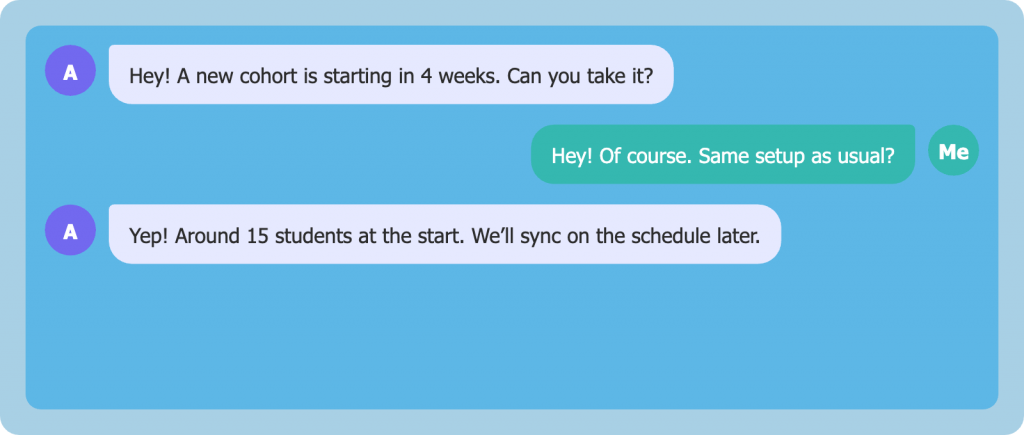
The course is structured in two modules. I mentor the first one. It contains four sprints, each lasting two weeks, plus one extra week for refinement after sprints two and four. That adds up to 10 weeks in total. The content volume is substantial, and every sprint ends with a project submission. The project spans the entire module and gradually increases in complexity.
The course is clearly aimed at adult learners—people who know why they enrolled (motivation) and can manage their time effectively (time management). Adults, unfortunately, deal with more competing priorities than children or teens: full-time jobs, families, future planning. These factors can either hinder or help their progress. And adults also bring prior experience—this can also cut both ways.
So we end up working with a group of adults who have (1) different motivations, (2) different time management abilities, and (3) diverse backgrounds. Managing such a mix is tough, and getting 100% positive feedback from 100% of the students is unrealistic. But there are best practices and strategies that help build a solid foundation for teaching adults. The individual approach should cover the exceptions—and there will always be exceptions.
Obvious and less obvious tools: The Dunning–Kruger Effect
So, the briefing’s done—it’s learning time! My toolkit includes:
- Theory materials on an online platform (similar to Coursera or Udemy, but text-heavy)
- A coding trainer with automated test cases (think LeetCode adapted to our curriculum)
- A group chat with topic-specific channels just for my cohort
- Weekly webinars I host live, with recordings posted afterward
It all sounds great. And at first, students see it the same way—huge enthusiasm in the first hours. But then what? That enthusiasm might fade. And we can prepare for that by introducing a couple of non-academic tools to track cohort dynamics. The first one is the Dunning–Kruger Effect.
The Dunning–Kruger Effect

This well-known hypothesis—formulated by Justin Kruger and David Dunning in 1999—describes four stages people often go through when learning something new:
- Initial overconfidence: The beginner feels excited and confident. Everything seems simple and clear.
- The crash: Confidence drops sharply. The learner realizes how much they don’t understand. They enter the “valley of despair,” where learning feels hard and progress seems impossible.
- Recovery: Slowly, the learner climbs the “slope of enlightenment” as they build competence and confidence.
- Stability: On the “plateau of sustainability,” new concepts no longer feel intimidating. The learner keeps growing steadily.
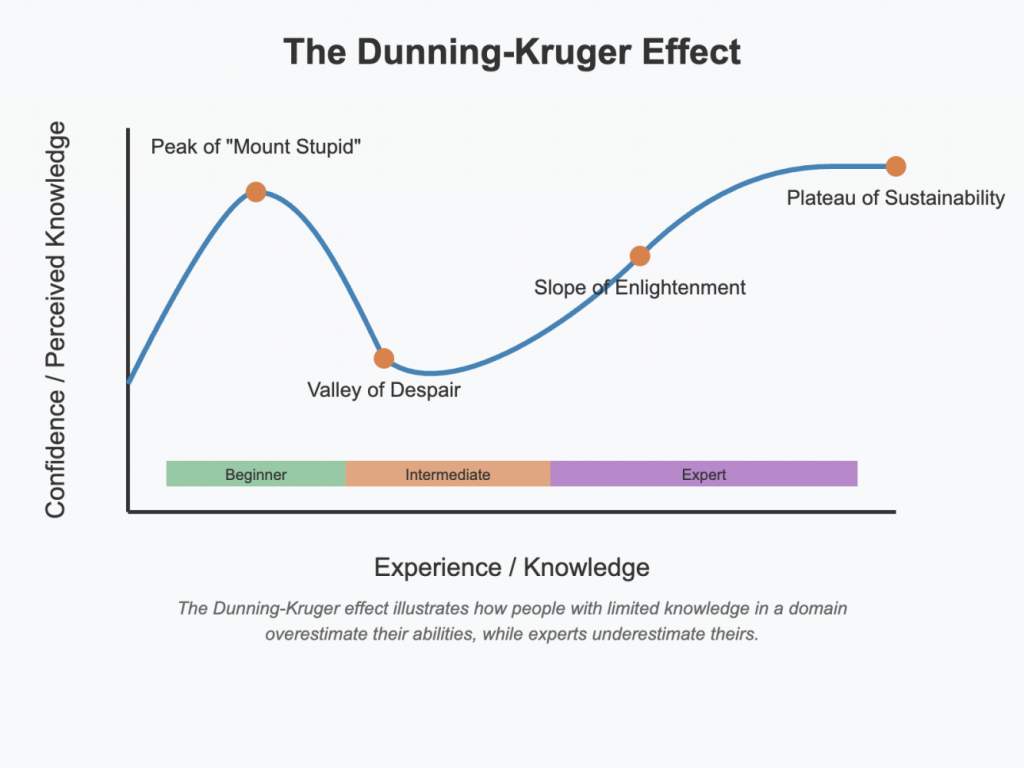
Ideally, learners go through stages 1–3 in university and reach stage 4 by the time they enter the workforce. But in adult education, these stages often compress into months or even weeks. That’s a serious challenge, especially around stage 2. Everyone hits it at different times, but if you know your course’s structure, you can anticipate the first major drop in morale and help students through it.
Now, the effect itself is debated—it’s difficult to verify statistically. Some see it as a philosophical idea, not a scientific fact. (Confucius once said, “True knowledge is knowing the extent of one’s ignorance.”) But if a pattern has been observed for centuries, it’s probably worth relying on, don’t you think?
Obvious and less obvious tools: Advanced webinars and lectures
Now that we’ve got a hypothesis, a program, and a set of tools, let’s break down their complexity and implementation.
- Asynchronous chats: Pros: async by design Cons: you still need to reply and keep track Workload scales with student activity (typically, 5 out of 25–30 students are very active) Complexity: 3/5 depending on engagement level
- Coding trainer: Pros: fully automated Cons: third-party solutions may be expensive and require tech support Complexity: 4/5
- Course materials: Pros: asynchronous, covers all topics Cons: less engaging than live teaching, needs regular updates, easily becomes boring Complexity: 2/5 for dry lectures, 4/5 for modern, engaging formats
- Webinars/workshops: Pros: live interaction, high engagement Cons: need prep (tech check, materials, etc.) Risk of turning into dull monologues Complexity: up to 5/5 if using advanced techniques
So how do we go beyond just reading slides? Ideally, you’re not just a mentor or instructor—you’re also a domain expert. That means you can tell stories.
Storytelling activates the audience and hooks them on ideas. For instance, when I explain abstract topics like app architecture, I mention things like MVC, Flux, and Clean Architecture. But what really resonates is when I share how we tried to implement Clean Architecture in our product, experimented with FSD, and why teams ended up defining their own structures despite our recommendations.
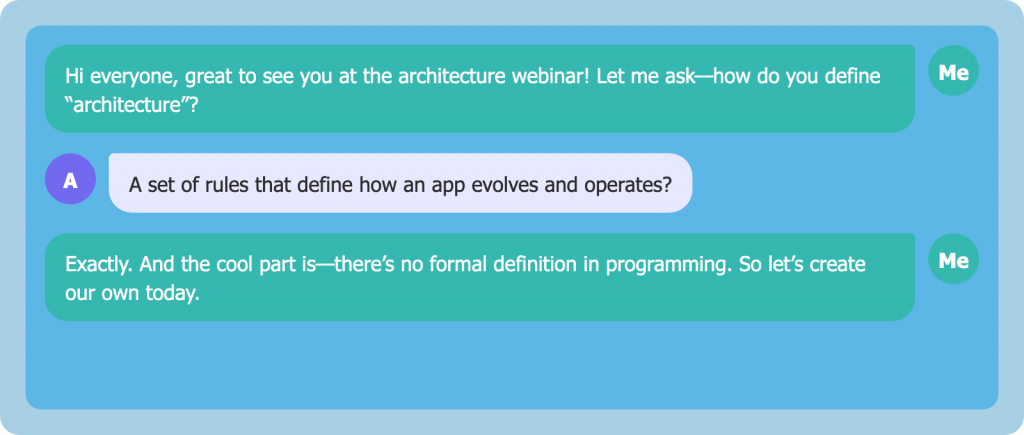
After a good story, show something. Visualization helps. Not full-blown diagrams that appear all at once, but evolving visuals—start small, then add layers. Think of Jake Archibald’s video on the event loop—an animated explanation that builds up concepts gradually. These can stay useful for years if based on foundational tech.
Analogies are also powerful—explain design patterns through LEGO, traffic rules, or assembly lines.
Other formats? Quizzes, polls, surveys. Interaction is key. Without it, you’re the only active participant. Students become passive, and that’s dangerous. I’ve noticed that after my less interactive lectures, students often ask questions I literally answered during the session. It just didn’t register.
Another framework: Kolb’s Learning Cycle
When you bring learners together—virtually or in-person—you can follow the classic model (teacher speaks, student listens) or try a more egalitarian approach, especially with adults who carry decades of life and work experience. That’s where Kolb’s cycle comes in.

Kolb’s model focuses on applied learning. It says students learn best through this cycle:
Experience → Reflection → Theory → Experimentation
- Concrete Experience The student tries to solve a new problem using their current understanding. This often leads to failure or suboptimal results—but that’s part of the learning process.
- Reflective Observation The student reviews the outcome and reflects on what went wrong (or right). They analyze their approach, spot gaps, and start asking better questions.
- Abstract Conceptualization/Theory The student acquires new theoretical knowledge—reading documentation, watching a lecture, or discussing with a mentor—that helps explain what happened and what could work better.
- Active Experimentation With fresh insights, the student tries a new implementation—this time with a more sophisticated understanding of the problem and solution space.

The ability to apply knowledge practically is key. Theory alone rarely sticks—but success or failure in action does. And failures must happen in a safe environment.
Creating a safe space and community
Building a safe learning environment is hard. Building a self-sustaining one is even harder. We’re talking about community now.
You’ve seen the trope—interns hanging out between sessions, sharing challenges (like in The Rookie or The Internship, which, by the way, hits many of our industry’s quirks). That happens in movies because the script says so. In reality? Much harder. In online learning? Nearly impossible.
When we ran an internship program at work, I loved seeing interns chat over coffee after hours. But that kind of bonding happens because they work and learn in the same space. When the training happens outside the org, it’s tougher.
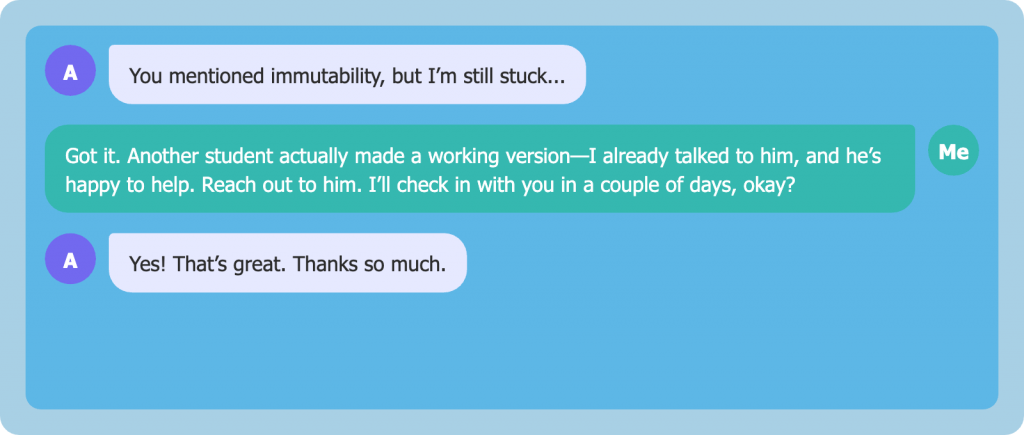
If students don’t organically form a community, you can help. Let’s say student A solved a problem that student B is struggling with. You can suggest B ask A for help. That reduces your own load, helps A deepen their knowledge, and teaches B to ask the right questions. But follow up: make sure A is willing and that B had a good experience. If it works, grow that mini-network.
A healthy learning community is incredibly powerful—but managing it takes real effort.
AI: a tool, not a Pinkerton agent
AI tools are booming, and while some fear them, I don’t. I use them—and I encourage students to do the same.
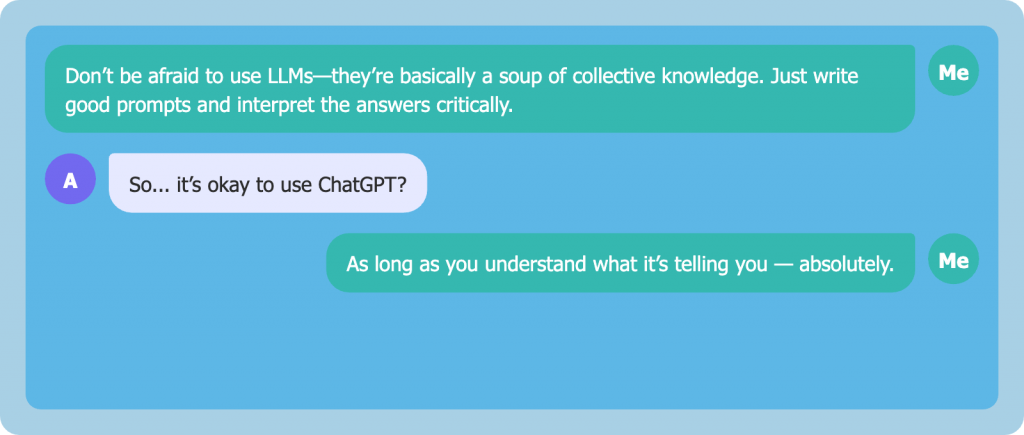
I’m a big fan of Anthropic’s Claude. I’ve built apps with it, but it’s also a great 24/7 assistant. Students can ask questions anytime (though they should learn how to write good prompts). You can also use LLMs to:
- Review and refine lecture content
- Generate presentations
- Analyze webinar transcripts
- And more (with the right setup)
These tools help you do more with less. You can even design custom prompts that help students dive deeper into a problem—not just get the answer.
The ultimate solution: 1-on-1 learning
After exploring group dynamics, tools, and formats, we land on the most effective solution: personalized instruction.
If you have the time and energy to tailor your teaching to each student, outcomes improve dramatically. But don’t confuse this with turning your class into a giant tutoring group. It doesn’t scale. 1-on-1 is best—but not feasible for everyone.
The ideal compromise? Small groups. The “two pizza rule” from IT companies is a great guide. If two pizzas can feed your team, it’s the right size. That’s about six people. Use this formula to estimate communication complexity:
n(n-1)/2, where n = group size
As the teacher, your relationships are key. Six people is a good max—enough to check in with each one. If you manage several groups like this, that’s plenty.
What’s left behind: tracking results
One thing this overview doesn’t dive into is tracking student progress. That requires a set of metrics, which will vary depending on your domain, the duration of the course, and other factors.
There are plenty of ways to assess progress, which roughly fall into two categories:
- Automated assessments: These include multiple-choice quizzes and modern tools that can also check short-answer and open-ended responses.
- Project-based evaluations: These require human input—like code reviews, essays, mechanical builds, or anything that demands personalized assessment.
Beyond dedicated assessment events, you can also monitor students’ day-to-day work—if applicable (like in The Rookie series). But this is a big and complex topic in itself, and something I’m still exploring. So stay tuned.
In the meantime, let’s wrap things up with a quick recap of key ideas.
TL;DR: Key Takeaways
Unique Challenges in Adult Learning
- Adult learners bring diverse motivations, time management skills, and prior experience
- Competing life priorities (jobs, families, obligations) affect engagement
- Previous experience can either accelerate or hinder the learning process
- Adults need to clearly see the practical value of what they’re learning
Psychological Aspects of Learning
- The Dunning–Kruger effect can help anticipate motivational dips
- It’s essential to create a safe environment for experimentation and failure
- Learners progress through varying levels of confidence—adapt to each stage
- Ongoing feedback helps students better gauge their growth
Balancing Online Learning Tools
- Asynchronous tools (chats, materials, trainers) offer flexibility but require discipline
- Synchronous formats (webinars, workshops) increase engagement but need more prep
- The best learning experience blends both formats to suit the group’s needs
- All technical tools must be reliable and easy to use
Engagement Strategies
- Storytelling and real-world examples increase relevance
- Step-by-step visualizations make complex ideas easier to grasp
- Interactive tools (polls, group tasks) boost student participation
- Analogies from everyday life help simplify abstract concepts
Kolb’s Experiential Learning Model
- The cycle: Experience → Reflection → Theory → Experimentation
- Practical application is the cornerstone of retention
- Reflection time is crucial—don’t skip it
- Theory should build on what’s already been experienced
Building a Learning Community
- Peer support and knowledge sharing strengthen engagement
- Instructors can act as connectors between learners
- Optimal group size: 6–8 people (the “two pizza rule”)
- Peer mentorship reinforces knowledge for both parties
Integrating AI Tools
- LLMs can serve as 24/7 teaching assistants
- Custom prompts help steer AI for educational purposes
- AI can automate routine tasks like grading or answering FAQs
- Students need guidance on how to effectively use AI in learning
Balancing Group and Individual Approaches
- 1-on-1 teaching yields great results but doesn’t scale well
- Small group formats preserve personalization while staying efficient
- Group learning works best for foundational skills and soft skills
- Hybrid models (lectures + personal check-ins) hit the sweet spot
Evaluating Learning Outcomes
- Use a mix of automated metrics and qualitative assessments
- Projects are a powerful way to assess applied skills
- Monitoring ongoing activity can be more telling than final exams
- Self-evaluation should be part of the learning metrics
Adapting to Rapidly Evolving Tech
- Focus on principles rather than specific tools
- Course materials must be regularly updated
- Instructors should stay active in their domain
- Train students to become independent learners who can adapt fast
Final Thoughts
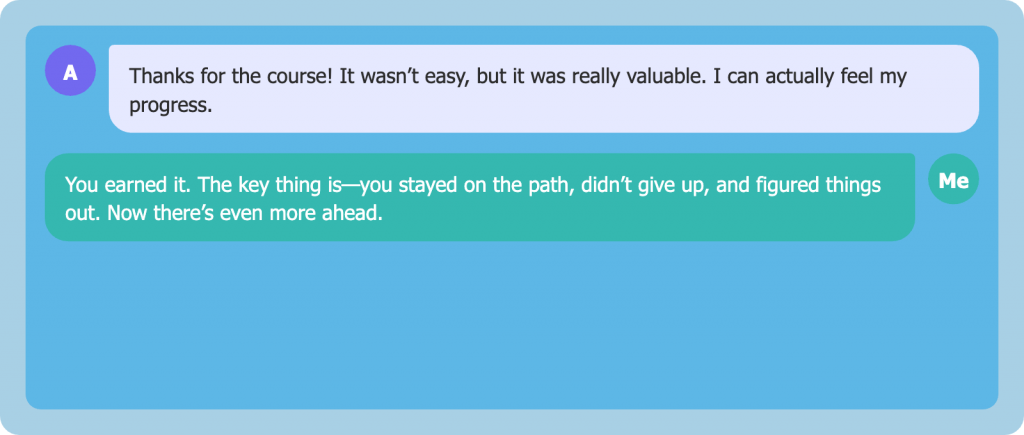
The modern world demands modern skills. And modern skills demand modern teaching methods to be delivered effectively. That doesn’t diminish the value of fundamentals—physics, linear algebra, and core sciences still matter. But in many cases, learners need fast, targeted knowledge to meet the expectations of today’s job market and fast-moving tech landscape.
And I believe the pace of change will only accelerate. So it’s up to us to prepare people for that future.